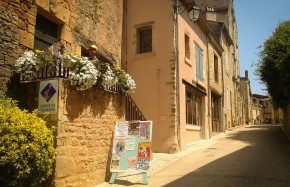Belvès
Belvès is a medieval town perched on a rocky spur above the Nauze Valley in Périgord Noir. It boasts seven bell towers and although it has endured numerous invasions and wars, it has miraculously managed to preserve superb relics of its built heritage. These include churches and stone houses once occupied by noblemen, both French and English. For its rich history, we arrived in Belvès mid-afternoon and found its streets humming with visitors on market day. After a quick lunch at a café on the edge of town, we set out on a tour of the inner village. Narrow streets wind their way upward toward the village square, where you get a real sense of why Belvès has been so coveted by outsiders over the centuries. The market was in full swing when we got there and vendors were selling everything from roasted chickens to local meats and cheeses.
Off the square is the Tower Filhols, with an 11th Century belfry built in 1450. Up the street is the Hotel Bontemps, once a nobleman’s house built in 1520. Through a castrum archway you enter a row of medieval houses that have been the subject of several local artists. Personalities linked to the common are Michael Butcher, a French rugby player born in Belvès in the 1940s; Guy Lanauve, a 20th Century French novelist; and Jacques Rispal, a French actor who helped the Jews escape the Nazi regime in World War II. The first raid against the Jews in the Dordogne begins on August 26, 1942 in Belvès, where a total of 329 people were arrested. No lack of significant historical events have occurred in this fair town.
I appreciate Belvès for all that it represents and for its place in history, but I don’t think this is the location that best fits the story of our film. The many shops and galleries in the village are attractive, but for all the business going on around us, it doesn’t have the same allure as Sarlat-la-Canéda or other towns of similar size.
































